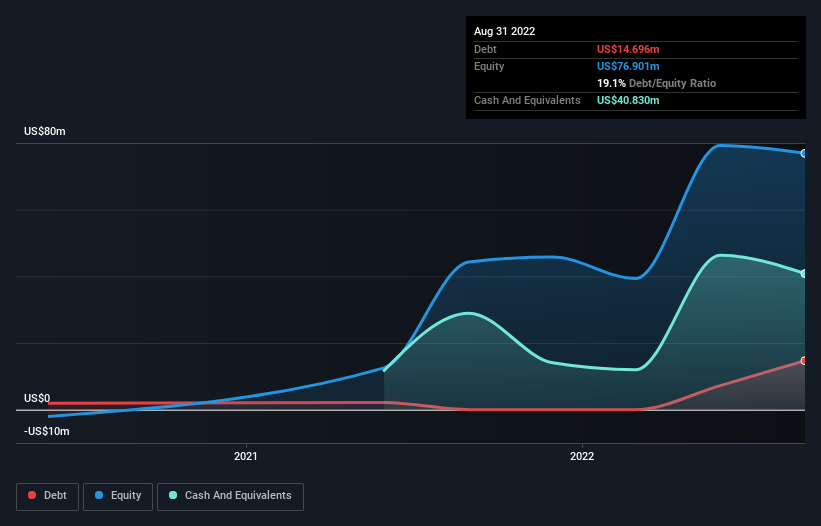
The external fund manager backed by Berkshire Hathaway's Charlie Munger, Li Lu, makes no bones about it when he says 'The biggest investment risk is not the volatility of prices, but whether you will suffer a permanent loss of capital.' So it seems the smart money knows that debt - which is usually involved in bankruptcies - is a very important factor, when you assess how risky a company is. As with many other companies Applied Blockchain, Inc. (NASDAQ:APLD) makes use of debt. But the real question is whether this debt is making the company risky.
When Is Debt A Problem?
Debt and other liabilities become risky for a business when it cannot easily fulfill those obligations, either with free cash flow or by raising capital at an attractive price. In the worst case scenario, a company can go bankrupt if it cannot pay its creditors. While that is not too common, we often do see indebted companies permanently diluting shareholders because lenders force them to raise capital at a distressed price. Of course, plenty of companies use debt to fund growth, without any negative consequences. When we think about a company's use of debt, we first look at cash and debt together.
Check out the opportunities and risks within the US Software industry.
How Much Debt Does Applied Blockchain Carry?
You can click the graphic below for the historical numbers, but it shows that as of August 2022 Applied Blockchain had US$14.7m of debt, an increase on none, over one year. But it also has US$40.8m in cash to offset that, meaning it has US$26.1m net cash.

How Healthy Is Applied Blockchain's Balance Sheet?
According to the last reported balance sheet, Applied Blockchain had liabilities of US$48.7m due within 12 months, and liabilities of US$20.4m due beyond 12 months. Offsetting these obligations, it had cash of US$40.8m as well as receivables valued at US$50.0k due within 12 months. So its liabilities outweigh the sum of its cash and (near-term) receivables by US$28.1m.
Given Applied Blockchain has a market capitalization of US$229.3m, it's hard to believe these liabilities pose much threat. But there are sufficient liabilities that we would certainly recommend shareholders continue to monitor the balance sheet, going forward. Despite its noteworthy liabilities, Applied Blockchain boasts net cash, so it's fair to say it does not have a heavy debt load! The balance sheet is clearly the area to focus on when you are analysing debt. But it is future earnings, more than anything, that will determine Applied Blockchain's ability to maintain a healthy balance sheet going forward. So if you're focused on the future you can check out this free report showing analyst profit forecasts.
While it hasn't made a profit, at least Applied Blockchain booked its first revenue as a publicly listed company, in the last twelve months.
So How Risky Is Applied Blockchain?
We have no doubt that loss making companies are, in general, riskier than profitable ones. And the fact is that over the last twelve months Applied Blockchain lost money at the earnings before interest and tax (EBIT) line. Indeed, in that time it burnt through US$61m of cash and made a loss of US$13m. Given it only has net cash of US$26.1m, the company may need to raise more capital if it doesn't reach break-even soon. Summing up, we're a little skeptical of this one, as it seems fairly risky in the absence of free cashflow. When analysing debt levels, the balance sheet is the obvious place to start. However, not all investment risk resides within the balance sheet - far from it. For instance, we've identified 3 warning signs for Applied Blockchain (2 are significant) you should be aware of.
If you're interested in investing in businesses that can grow profits without the burden of debt, then check out this free list of growing businesses that have net cash on the balance sheet.
New: Manage All Your Stock Portfolios in One Place
We've created the ultimate portfolio companion for stock investors, and it's free.
• Connect an unlimited number of Portfolios and see your total in one currency
• Be alerted to new Warning Signs or Risks via email or mobile
• Track the Fair Value of your stocks
Have feedback on this article? Concerned about the content? Get in touch with us directly. Alternatively, email editorial-team (at) simplywallst.com.
This article by Simply Wall St is general in nature. We provide commentary based on historical data and analyst forecasts only using an unbiased methodology and our articles are not intended to be financial advice. It does not constitute a recommendation to buy or sell any stock, and does not take account of your objectives, or your financial situation. We aim to bring you long-term focused analysis driven by fundamental data. Note that our analysis may not factor in the latest price-sensitive company announcements or qualitative material. Simply Wall St has no position in any stocks mentioned.
About NasdaqGS:APLD
Applied Digital
Designs, develops, and operates digital infrastructure solutions and cloud services high-performance computing (HPC) and artificial intelligence industries in North America.
Moderate with mediocre balance sheet.


